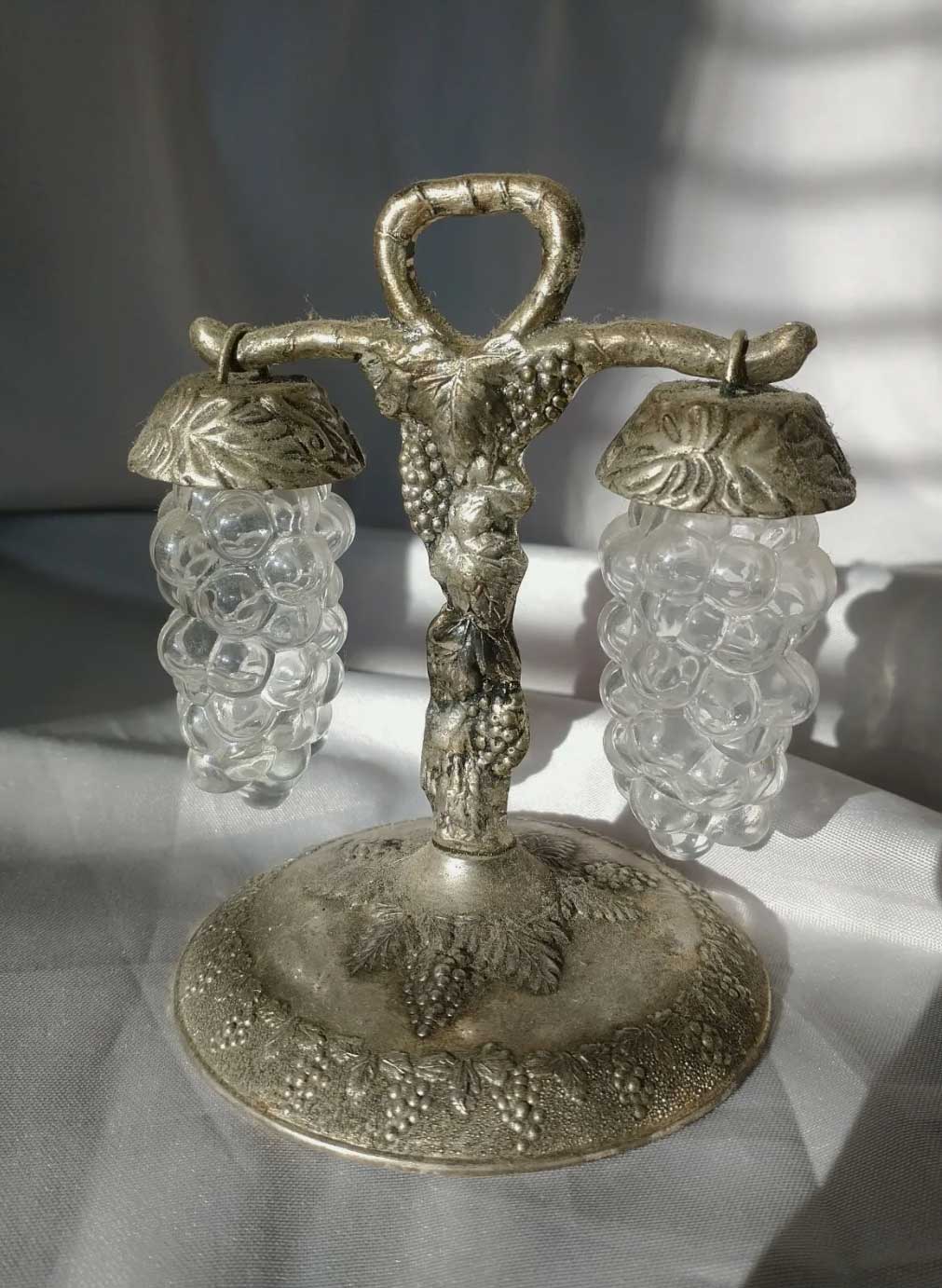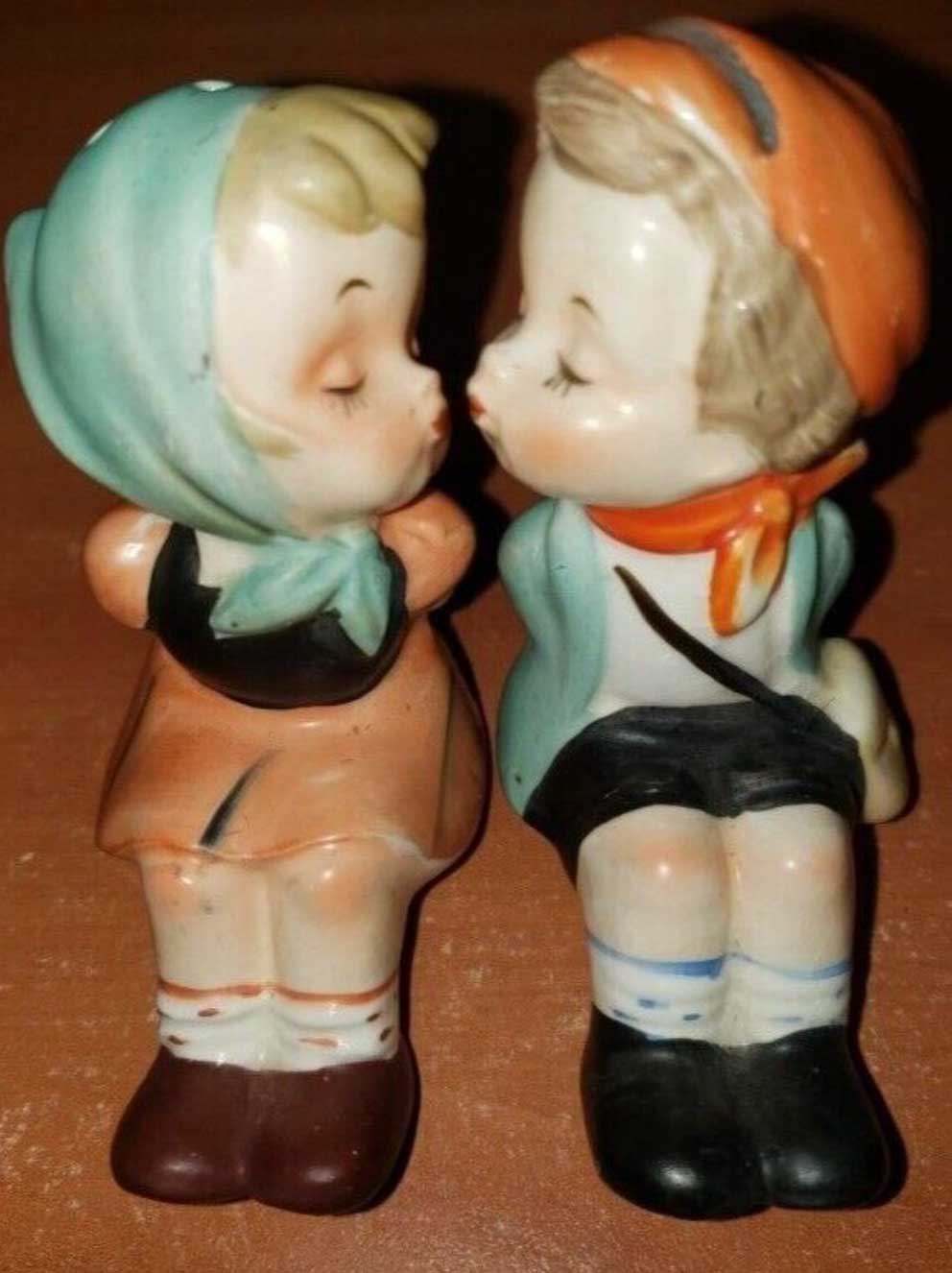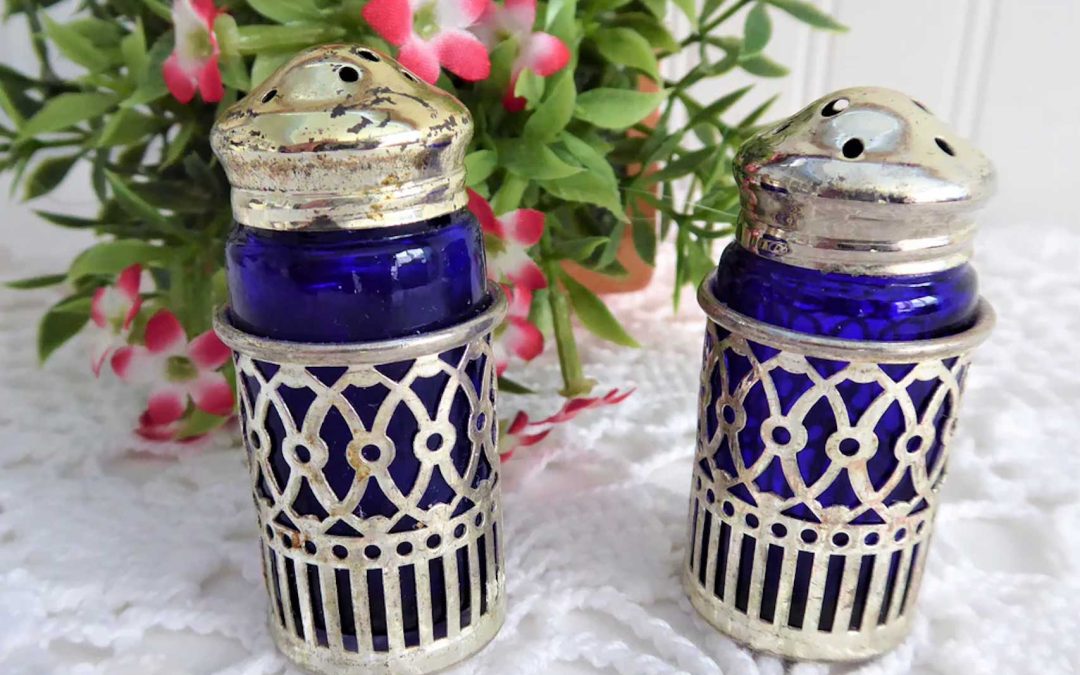These shakers have their original cobalt blue glass liners with silverplated frames and lids. (Image courtesy of Antiques and Teacups)
May 2024
Cover Story
Two of a kind
Salt and pepper shakers make inexpensive, colorful collectibles
by Corbin Crable
It’s one of the great culinary pairings of all time. There’s tomato and basil. Bacon and eggs. Pizza and beer.
And then there are two condiments that bring out the flavors in all of these and more: Salt and pepper, found together in shakers at nearly every table you see.
Once, only for the rich…
It wasn’t until the 17th century that salt and pepper found their respective mate at the kitchen table. Before that, salt was kept in a small bowl called a salt cellar and used with a small spoon. Native to India, black peppercorns were usually ground up in grinders at the table. Both seasonings were expensive to import before the 1600s, so the consumption of both was considered to be a symbol of wealth, especially in Europe, where they became more popular with time. Asian countries, meanwhile, used their own condiments to generate salty and peppery flavors – namely, soy sauce and crushed red pepper (Interestingly enough, Vietnam is the world’s top producer of black pepper today). We have a French chef, Francois Pierre LaVarenne, royal chef to King Louis XIV, to thank for first thinking to pair salt and pepper (the king had a reputation as a picky eater, and LaVarenne found that adding salt and pepper to his food made those dishes acceptable to the monarch).
“The pairing was a smash hit because pepper was the only spice that complemented salt and didn’t dominate the taste,” according to a 2021 article on All Recipes’ website.

These shakers are made of jadeite
Though most salt and pepper shakers were metal and ceramic beginning in the 1920s, these shakers are made of jadeite, a dense mineral usually emerald green in color. (Image courtesy of Replacements Ltd.)

Novelty Salt and Pepper Shakers Club
If you collect salt and pepper shakers, consider joining the Novelty Salt and Pepper Shakers Club. You can find them on Facebook and at www.saltandpepperclub.com. (Image courtesy of Facebook)
…Now for all
Salt and pepper prices dropped dramatically during the Industrial Revolution of the 19th century as the cost to ship the seasonings lowered. Now, the spices weren’t only for the rich and affluent – they became affordable for the everyday family.
Salt and pepper shakers themselves were invented during the Victorian era, created by the same inventor of the Mason Jar, American tinsmith John Mason. In 1858, he designed small jars with screw-top lids that featured holes in the top, so diners would be able to shake their seasonings right onto their food.
“Mason’s salt shaker was a container with a tin cap that had several holes punched through the top; however, his shaker was short-lived,” writes Lindsey Schier of The Des Moines County Historical Society. “Salt absorbs moisture and has a tendency to clump. This meant it did not flow freely out of the holes in Mason’s shaker.”
Even in those early years during the late 19th century and well into the 20th, salt and pepper shakers came in a variety of designs, making them highly collectible.
“In the 19th century, Staffordshire Potteries produced salt-and-pepper shakers as parts of cruet sets. Many of these were novelty characters with pink cheeks and big hats,” according to Collectors Weekly. “In the 1900s, with the advent of movies, shakers with character heads in the shapes of stars like Laurel and Hardy were popular—later, Staffordshire firms made more respectful sets bearing the stern images of famous cricket players either bowling or up to bat.”

Newer Sushi Shakers
These newer sushi shakers are some of the more recent units made in Japan by the Pacific Giftware Co. (Image courtesy of Facebook)

Cozy kitten shakers
This pair of cozy kitten shakers was manufactured by Holt Howard in 1958. (Image courtesy of eBay)
Trinkets to buy when traveling
In the early 20th century, The Morton Salt Co. added magnesium carbonate, an anti-caking agent, to the salt they marketed and sold. This made the popular seasonings easily shakable.
“Morton’s addition led to the use of salt shakers, but they did not really take off in popularity until the 1920s for a reason you might not expect,” Schier writes. “The rise in the automobile played a role in the increased sales of salt shakers and made them collectible items. Travel, whether for work or leisure, increased with the introduction of the automobile. With this increase came a rise in the souvenir industry.”
Now, the small, colorful, ceramic items were even more collectible. Due to their size, they didn’t cost much to ship as well. Schier writes that during the 1920s and ‘30s, Japan produced the greatest number of units – until the Second World War, of course. After the end of the war, makers of salt and pepper shakers began to branch out from ceramics and make the collectibles from other materials.

Grape looking glass shakers
These glass shakers, designed to look like grapes hanging off a vine, were made in the 1960s. (Image courtesy of eBay)
“Wood, silver, baser metals, and glass or a combination of these materials were all used to create salt shakers,” she writes. “As with most products, shakers ranged from the most basic, mass-produced such as those used in many restaurants, to the more unique and hand-crafted to something in between.”
Plastic shakers were introduced in the 1950s, but by the mid-20th century, there were several designs from which you could choose.
“Several trends were simultaneously in play. The first was toward a clean, white, sanitary look. That spawned square salt-and-pepper shakers made of milk glass and capped by threaded, metal lids in black, silver, Mandarin red, and Delft blue,” according to Collectors Weekly. “The painted designs on the sides of these milk glass shakers tended to be plain and simple—a Dutch boy or girl, a windmill, a black Scottie dog, flowers. Most lids were punctured with as few as one hole for pepper and multiple holes for salt, but some had dots forming the letters ‘S’ or ‘P’ drilled into their tops, lest there be any confusion about the contents inside.”
“A slice of Americana”
No matter what they’re made of or how rare some might be, you’ll probably find them at the Salt and Pepper Shaker Museum in Gatlinburg, TN. Started by archaeologist and shaker collector Andrea Ludden in 2002, the museum holds more than 20,000 salt and pepper shakers. Ludden’s collection, which also includes more than 1,500 pepper mills from around the world, continued to grow so large over the years following the museum’s opening that she opened a second location in Spain.
“Our mother was adamant about showcasing how you can trace history in salt and pepper shakers,” her daughter Andrea, who acts as administrator for the museum along with her brother, Alex, told USA Today in 2017 “She loved the idea of telling a story through them.”

Flag salt and pepper shakers for every occasion
The Salt and Pepper Shaker Museum in Gatlinburg, TN, has salt and pepper shakers for every occasion. This cute set will look perfect on your picnic table this summer. (Image courtesy of Facebook)

Kissing shakers
These kissing shakers, done in the Hummel style, were produced in the 1950s by Napco, another giant in the industry. (Image courtesy of eBay)
Collectors also have a place to belong at the Novelty Salt and Pepper Shakers Club Convention, which draws hundreds of collectors from all around the world and features names from familiar makers such as Fiesta, McCoy, and Napco. This year’s convention is coming up, July 11-13 in Canton, Ohio.
“They’re insane but very welcoming, really a slice of Americana,” event organizer Barbara Cummings joked in a 2015 article published in The Washington Post. “Great people, just the salt of the earth.
Not just for salt and pepper
Vintage salt and pepper shakers will bear a manufacturer’s mark on the bottom; most of them were made in the United States or Japan, according to online antique dealer 1st Dibs. And as far as value, their monetary value is based on rarity, condition, the materials from which they are made (such as high-quality metals). Shakers are sold throughout a wide price range, according to americasantiquemall.com, from a few dollars to thousands (one set of mixed metal shakers from Tiffany and Co. sold at auction for nearly $7,000 in 2013, according to the Smithsonian Institute).
Surprisingly enough, there are even uses for these trinkets beyond merely acting as vessels for these two common seasonings. They can act as miniature vases, seed dispensers, or even pin cushions.
Whatever your reason for collecting them or whatever your use, such collections show no signs of waning popularity.
“Some people are crazy about salt and pepper shakers,” notes the blog It’s All Our Vault. “I can sort of see why: they’re tiny and usually pretty inexpensive. They make great gifts to give and receive. And they come in a million sizes and shapes. You can collect these things for your entire life and still not have a complete collection.”

Andrea Ludden, founder of The Salt and Pepper Shaker Museum
Andrea Ludden, founder of The Salt and Pepper Shaker Museum, shows off some of her collection. The museum, the only one of its kind in the United States, is located in Tennessee. (Image courtesy of The Salt and Pepper Shaker Museum)


